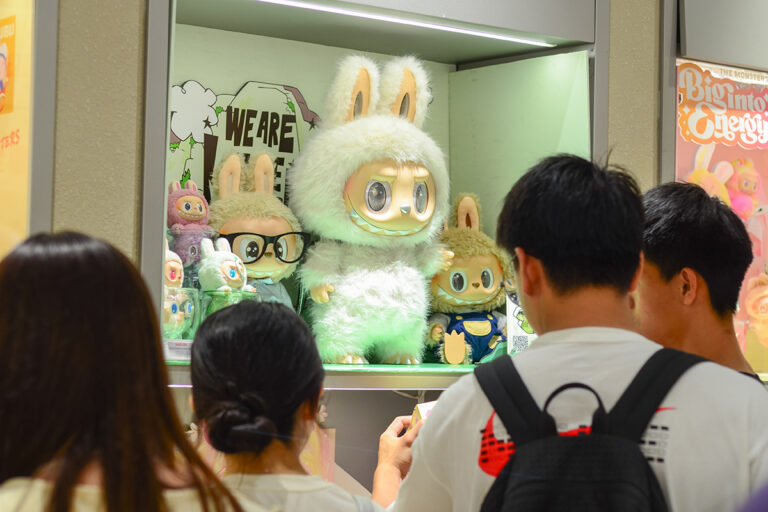By all accounts, the creature is hideous. With its bugged-out eyes, devilish grin, and posture that suggests it has just hatched a plan to haunt your sleep, Labubu is not what anyone would call conventionally cute. Yet here we are, grown adults living in a world where spending power is high and trends travel faster than traffic, hoarding these toys like they’re bricks of gold.
Labubu, a character from the Hong Kong-based Pop Mart universe, is the newest darling of the designer toy craze. Originally sold for under $20, some Labubus are now reselling for as much as $5,000 online, depending on rarity, edition, and box condition. A 4-foot mint-green model recently sold for $172,800 at auction in Beijing. If this is the new investment class, forgive me for being old-fashioned, but I miss the days when we bought stocks.
Labubu phenomenon
Price tag aside, what’s baffling to me is the narrative surrounding them. Friends well into their 30s are swapping Labubu tips like they’re talking property portfolios. Instagram is filled with videos of adults unboxing blind boxes with a trembling reverence usually reserved for engagement rings. In Dubai, it’s not unusual to see young women proudly showcasing shelves of Labubus next to Diptyque candles and Loewe bags.
It would be easy to dismiss this as nostalgia. After all, we’ve been here before. In the late 90s, Beanie Babies turned living rooms into speculative trading floors. A Princess Diana bear once sold for $500,000. Try selling one now and you’ll be lucky to get $5. But at least with Beanie Babies, the market felt more innocent. The internet was still in its infancy, eBay was the Wild West, and speculation didn’t masquerade as strategy.
The Labubu phenomenon, on the other hand, is hyper-modern. A toy being pitched as an “alternative asset.” The designer toy market grew 26 per cent over the past year, and prices for sought-after Labubus have surged over 741 per cent. Some platforms even suggest these toys belong in a “diversified portfolio” alongside ETFs and crypto.
Vertu, a luxury lifestyle publication, recently called Labubu “perfect for collectors and smart investors”. Forbes dubbed it a “cultural and commercial juggernaut.” The mechanics behind its success are artificial scarcity through blind boxes, limited drops, and celebrity endorsements from Rihanna and BLACKPINK’s Lisa. Add to that social media virality amplified by TikTok haul culture. Labubu has even dipped into NFTs, bridging physical collectibles with Web3. It’s a perfect storm of hype, novelty, and algorithmic obsession.
Let’s compare it with Furby — another strange, arguably creepy toy that once captured the imagination of millennials. While Furbies aren’t clogging luxury apartment shelves anymore, rare models still fetch decent prices from collectors. The difference is that Furbies were at least animated. Labubu just… sits there. And unlike Pokémon cards or rare sneakers, it doesn’t carry much cultural nostalgia or intergenerational storytelling. It’s a blank slate whose value is dictated almost entirely by manufactured scarcity and the social validation loop.

Here’s the thing. If people genuinely start seeing this as a serious form of investment, I’m sorry, but this is hype. And if history serves as a guide, hype never lasts. The Beanie Baby bubble was fuelled by novelty, not fundamentals. Labubu is similar — except now it’s being repackaged with glossy investor language and viral marketing. The veneer may be smarter, but the formula hasn’t changed.
Which brings me to the bigger issue. Why are we looking at novelties like Labubus when the region’s capital markets are booming? In the United Arab Emirates and Saudi Arabia, retail investors are making steady returns from IPOs. Broker platforms have become more accessible, and financial education is increasingly within reach. Yet, some are still drawn to toys over traditional investing. This is a symptom of hyper-driven consumerism and the strange incentives of modern capitalism.
It’s not that I don’t understand the appeal of collecting. I do. But there’s a difference between curating a personal art collection and flipping a plastic troll for rent money. At what point does “fun” cross into financial delusion? Are we really okay with normalising speculative trading of children’s figurines while dismissing actual investment vehicles that could grow personal wealth over time?
This is the paradox. We say we want stability, yet we’re drawn to the chaos of hype. Labubu is the symptom of a broader cultural pattern: our obsession with identity-driven consumption. For many, buying one is less about joy and more about being seen. It’s a symbol, a statement, a membership badge to an exclusive internet club. It’s Instagrammable capital. But like all capital built on vibes, it’s volatile.
And maybe that’s the biggest lesson from the Beanie Baby crash. Scarcity can be manufactured, demand can be inflated, and value is only real if it’s sustained — if it outlasts the trend. The difference today is that social platforms can compress the entire cycle of mania and collapse into a few weeks. Beanie Babies took years to fade. Labubu could implode in an afternoon if TikTok decides it’s cringe.
Ultimately, we should be asking: who decides when these things are valuable? The market? Influencers? A marketing team in Shenzhen with a spreadsheet and an algorithm?
You’ll have to forgive my scepticism. I’m just not convinced. In an era where AI is transforming entire industries, where sovereign wealth funds are investing in real innovation, and where millennials and Gen Z finally have greater access than before to tools that can build generational wealth, it seems absurd that so many are betting big on something that looks like it crawled out of a fever dream.
Cute or creepy, Labubu is less about joy and more about FOMO. And that’s the kind of market trend history usually writes off with a smirk.

